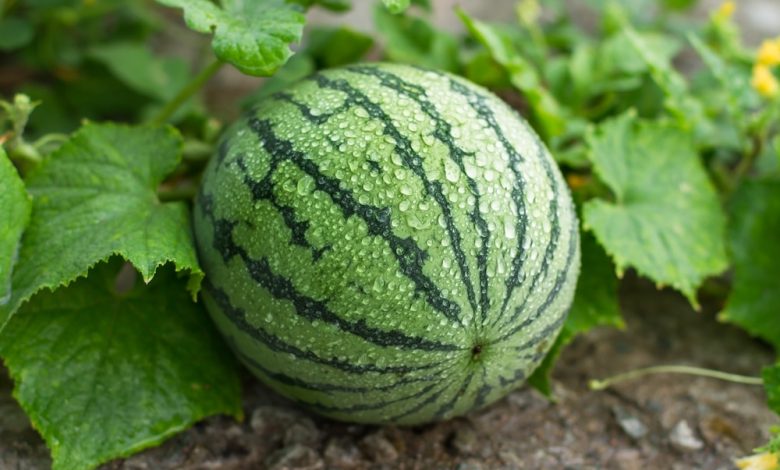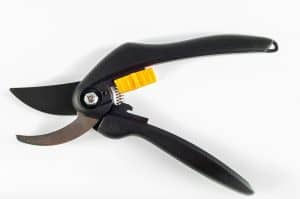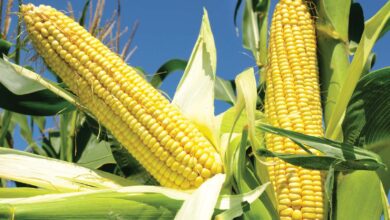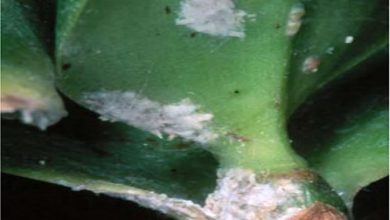The [12 Steps] You Must Follow to Grow Watermelons Successfully

Plant Watermelons Step by Step:
- When? Between April and May.
- Where? Area with lots of sunlight.
- Harvest time? Between 3-4 months.

- How do we prepare the land? The pH between 6.5 and 7. Compost with organic matter, manure and earthworm humus. We till the land with a motorized tiller.
- How do we water? Ideal, with drip.
- How often do we water? At first daily, about 30 minutes. When the plant gains strength we can reduce the frequency to 2-3 days, always paying attention to the color of the leaves and increasing if they lack water.
- How do we sow? About 4 seeds, about 2cm deep. We will leave about 30cm of separation distance, because the watermelon is a plant that grows a lot and takes up a lot of space.
- When do we harvest? Hitting the fruit with the fingers produces a dull sound.
- Good associations? Corn, chard, spinach, peas, radishes, lentils, oregano, cabbage, beans, garlic, onion, leek and lettuce.
- Bad associations? The cucumber, because it takes up a lot of space too.
- Diseases and pests? Aphids, spider mites, whiteflies, thrips, nematodes, powdery mildew, vascular diseases,gummy stem canker.
Generally speaking, watermelon is the favorite summer fruit.
It is refreshing, since it is composed of more than 90% water. We can consume it in salads, mix it in our cocktails, make it in water or consume it in slices.
But what is little known is that this fruit suffers from a serious identity problem. Some experts refer to it as a vegetable, while others consider it unmistakably a fruit. Who has the reason?
In reality, the confusion occurs because the watermelon is a cucurbit, which is why it is related to the cucumber and pumpkins.
It is grown as a fruiting vegetable and is generally treated as a vegetable for culinary uses.
However, it is considered a fruit because it develops from the plant ‘s ovary after flowering and contains seeds.
What is undeniable is its delicious flavor and its high nutritional value, which makes it a fruit that should not be missing from our regular diet.
Did you know…There are more than 1,200 varieties of watermelons grown in 96 countries.  The organic family garden (CROPS)
The organic family garden (CROPS)
- Well, Mariano (Author)
€9.49 View on Amazon Prices with VAT without transport
Last updated on 2022-07-31 / Affiliate Links / Affiliate API Images
Main benefits of watermelons
In addition to being diuretic, watermelon is rich in antioxidants, vitamins and minerals that are very beneficial for our body.
Among its main characteristics we can mention:
- Prevents the risk of cardiovascular diseases. Eating watermelon reduces blood pressure thanks to its high content of citrulline, a non-essential amino acid that is found mainly in the white part that surrounds the pulp.
- It is rich in lycopene, a natural pigment precursor of beta- carotene, an antioxidant that is transformed into vitamin A.
- It is a fruit with a good supply of antioxidants, which protect us against chronic diseases, favor the formation of red blood cells and delay aging.
- Additionally, lycopene helps decrease inflammation.
- Reduces the risk of eye diseases. This thanks to lutein and zeaxanthin, two substances with protective properties against cataracts and macular degeneration.
- Rich in iron, magnesium, potassium, phosphorus and calcium.
- Relieves muscle pain. It also helps fight fatigue.
- It is moisturizing and laxative.
- It has antioxidant effect.
- It has a high content of vitamin A and C.
- Due to its high water content, it favors the proper functioning of the kidneys. For this reason, it is a fruit that facilitates the expulsion of toxins from the body, regulates blood pressure and reduces fluid retention.
main features
Citrullus lanatus, commonly called watermelon, syndria, watermelon, aguamelon or water melon is a fruit of the Cucurbitaceae family and is a type of fruiting vegetable.
It is a herbaceous plant with an annual cycle, rough in texture, with hairy stems provided with tendrils and leaves with five deep lobes.
 Its fruit is spherical and very large (normally more than 4 kilos), fleshy and very juicy.
Its fruit is spherical and very large (normally more than 4 kilos), fleshy and very juicy.
Its outer skin is smooth in texture and without porosities, green in two or more shades. The pulp is red in color and sweet in taste.
The watermelon is considered to be native to Africa and its cultivation dates back to the banks of the Nile, from where it spread throughout the Mediterranean.
In Spain it was introduced by the Arabs and is currently cultivated throughout the Peninsula, mainly in Andalusia and in the east.
It was brought to America by Christopher Columbus on one of his voyages.
Today, there is evidence of a great diversity of watermelon varieties, which are classified according to their shape, color, weight and ripening period. To know more, read: Varieties of watermelon.
Although genetically we find only two types of watermelons.
Did you know…China is the main producer of watermelons in the world.
No products found.
diploid watermelons
They are varieties with seeds. There are two ways:
- elongated. Green bark with lighter colored bands. The Klondike watermelon and the Charleston Gray watermelon stand out.
- round. Dark green or black in color. Among the most cultivated we find the Crimson Sweet watermelon, the Resistent watermelon, the Sugar Baby and the Dulce Maravilla.
triploid watermelons
They are varieties that have tender white seeds that go unnoticed when eating the fruit. Its bark is light green, with darker stripes. Its pulp can be red or yellow.
Among the most cultivated we find the Queen of Hearts watermelon, the Apirena watermelon and the Pepsin watermelon.
Necessary conditions for planting watermelons
To plant watermelon we must pay attention to the following requirements:
The Nutrients
Watermelons are not very demanding in terms of nutrients, although it is recommended to put some homemade organic matter such as mature and well-decomposed compost in each hole where the seeds are sown or the transplant is made.
If you mix compost with some type of chip or sawdust it will be ideal.
the substrate
The watermelon is not very demanding at this point, but it gives better results in soils rich in organic matter, and well drained.
Substrate Tips
 We will seek to plant watermelons in sunny areas and in soft and well-fertilized land.
We will seek to plant watermelons in sunny areas and in soft and well-fertilized land.
Watermelons, for their growth, require a minimum of 6 hours of sun a day, but the shoots must be protected from the sun if it is very intense.
For planting on land, the soil is mixed with highly decomposed compost.
Spread it evenly over the planting bed to create a rich feeding area for the watermelon.
For this, the most suitable is 15 to 20 cm of well-tilled soil.
Remember:Remember that watermelons are demanding in terms of drainage, as waterlogging can cause root suffocation and fruit rot.
If your garden is prone to flooding, you need to do everything you can to fix it.

You can create slopes so water runs off to the side and install gutters to make it easier to collect water.
Another effective technique is to create mounds of soil and plant on them, so less water will accumulate at the foot of your plants.
At planting time, add a good amount of mulch, compost, peat or manure to fluff up the soil and aerate it.
If you also add river sand and mix it well with the soil, the result will be favorable.
In extreme cases, it is best to install a network of drainage pipes.
Keep in mind that if irrigation is excessive or very deficient, up to 50% of production can be lost, just like melons.
Watermelons grow best in soil with pH levels between 6 to 6.8.
Before planting watermelons
The seeds
The seed for planting watermelon is extracted from the ripe fruits. It is important that you choose the variety based on the space you have in your garden or where you want to plant it, as there are varieties that require a lot of space to grow.
pH
Optimal pH values range between 6 and 6.8
the fertilizer
Apply compost, worm humus or manure in large quantities a month before cultivation.
To know more: How to pay watermelons.
CULIVERS Organic Worm Humus. Plant food. 100% Natural Organic Fertilizer. Soil Restorative (Tomatoes and Vegetables, 20 Kg)
- Worm humus of the highest quality 100% organic.
- Organic matter rich in microorganisms. (1 gram of humus contains about 2 billion microorganisms) The…
- Stimulator of the root development of plants and their absorption of nutrients. It has a neutral pH that makes it ideal for…
- Ecoforce worm humus increases the quality and production of crops. It has a low C/N ratio, allowing…
€19.90 View on Amazon Prices with VAT without transport
Last updated on 2022-07-31 / Affiliate Links / Affiliate API Images
Where do we plant them?
Preferably outdoors. With direct sun.
The watermelon is less demanding in temperature than the melon.
When the differences in temperature between day and night reach 20 to 30 ºC, imbalances are caused in the plants.
In certain cases, the neck and stems open, and the pollen produced is not viable.
Did you know…In Israel and Egypt, the sweet taste of watermelon is often combined with the salty taste of feta cheese.
land preparation
The soil must have good filtering. Also, it should be loose enough, without being compressed.
If you plant in a pot, a good recommendation is to mix two parts of soil and one part of sand.
The soil provides your plant with the nutrients it needs, while the sand controls moisture.
Till the area where you are going to plant your watermelons.
Consider that these produce long vines that take up a lot of space, so give each one a 1 x 2 meter space.
Next, you need to make mounds for planting. Watermelons grow best on mounds that are raised slightly above the ground.
Each mound must have 6 cms. tall. The ideal is that between each mound you leave at least 2 meters of separation.
Planting
On what date?

Between April and May.
The watermelon planting process
Sow 4 seeds in each mound of soil that you have formed, at a depth of 2 cm.
Next, protect your seeds with mulch. Place some mature, well-decomposed compost in each mound.
Blumfeldt Timberflor Plant Pot, Plant Pot, Easy to Place, No Drainage Hole, Fiberglass, Sturdy, for Indoors and Outdoors, Wood Look, 60 x 50 x 30 cm, Brown
- FOR INDOOR AND OUTDOOR: In the Blumfeldt Timberflor pot shrubs, perennials or flowers have a new…
- JAPANESE ZEN AESTHETICS: The Timberflor planter shows the best side of plants and combines it with an elegant design and…
- GOOD QUALITY MATERIAL: It does not matter if the pot remains indoors or outdoors. The new combination of…
- STABLE AND ROBUST: Despite being a much lighter pot than any other concrete or terracotta pot on the…
€109.99 View on Amazon Prices with VAT without transport
Last updated on 2022-07-31 / Affiliate Links / Affiliate API Images
Irrigation
Although they are fruits with a high water content, their water needs are actually low.
It is advisable to drip water them to prevent the leaves from getting wet, as they rot easily.
Tips on watering

They require daily but regulated irrigation, only to maintain soil moisture.
When the plants reach 8 cms. You must reduce the irrigation and do it every 3 days, just making sure that the soil does not dry out completely.
Keep foliage and nuts. You can put the fruits on a clean piece of wood, a large smooth stone, a brick, etc.
On very hot days, the leaves may wilt, even if the soil is moist.
If the leaves continue to fall the next day, water them with plenty of water.
Watermelons get sweeter if you stop watering a week before harvest. After the harvest, water regularly again to favor the next harvest.
Did you know…Every part of the watermelon is edible, even the seeds and the rind.
The first shoots
On average, the seeds take between 5 and 15 days to germinate.
When the first plants have sprouted, we will uproot the weakest and leave only the healthiest and most vigorous plant.
the transplant
The transplant from the seedbed to the final site will be done when the plant reaches about 15 cms. Tall.
Put some decomposed compost in each place where you transplant the plant.
A good idea is to cover the rows with netting to keep them warm and protect them from insects.
Did you know…In Japan they grow watermelons in square cubes so that the fruit adopts this shape. This is done with the intention of storing them more easily.
watermelon pruning
 Pruning watermelons is important to maximize fruit production and improve yields.
Pruning watermelons is important to maximize fruit production and improve yields.
But… how should we do it?
There are several methods. However, we recommend one that gives good results and is simple.
It consists of removing all the shoots of the watermelon, except for the two most vigorous.
In any case, if you want to know more about pruning watermelons, check out this article.
Waldbeck Power Planter Pot with 3-tier stake (75x130x35cm, intelligent irrigation system, planter for garden or balcony)
- El jardín en el balcón: maceta para cultivar tus propias verduras o flores en el balcón o terraza. Estable acabado de…
- Tutor de 3 niveles para un crecimiento estable y recto de la planta. Aprender de la naturaleza: ideal para aprender a…
- Dos aperturas de riego en la parte inferior: sin humedad directa en la planta. Reservas de agua en la parte inferiorde la…
- ¡Es verano, es tiempo de verduras frescas! La maceta Power Planter de Waldbeck conviertetubalcón o terraza…
69,99 EUR Ver en Amazon Precios con IVA sin transporte
Última actualización el 2022-07-31 / Enlaces de afiliados / Imágenes de la API para Afiliados
La cosecha y recolección
Las sandías estarán listas aproximadamente a los 4 meses de cultivo
El tiempo de recolección se determina por los siguientes síntomas externos:
- El zarcillo rizado que se forma cerca del tallo está completamente seco o la primera hoja situada por encima del fruto está marchita.
- Al golpear el fruto con los dedos se produce un sonido sordo.
- Al rayar la piel con las uñas, ésta se separa fácilmente.
Asociaciones favorables
Se asocia muy bien con el maíz y con las acelgas.
Además, puedes sembrarlas con espinacas, guisantes, rabanitos, coles, judías, ajo, cebolla, puerro y lechugas.
Asociaciones poco favorables
No combina bien con el pepino, ya que terminan compitiendo por el espacio.

![Photo of Christmas Cactus: [Growing, Care, Irrigation and Substrate]](https://www.complete-gardening.com/wp-content/uploads/2022/08/christmas-cactus-growing-care-irrigation-and-substrate-390x220.jpg)

